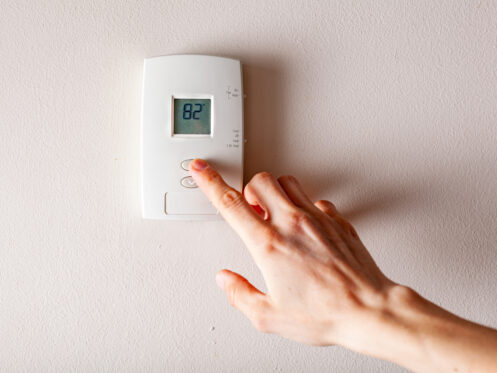When your heater isn’t turning on, it can be quite an inconvenience, especially during those chilly months when you need warmth the most. Knowing the common reasons for this issue is important for homeowners. By knowing what to look for, you can often address minor issues yourself or know when it’s time to call in the experts. In this article, we’ll explore some common reasons why your heater might not be working, provide troubleshooting tips, and discuss preventive measures to keep your heating system running smoothly.
Common Reasons for Heater Not Turning On
There are several reasons why a heater might not turn on, and identifying these can help you find a solution more quickly:
- Thermostat Issues: Sometimes, it’s just incorrect thermostat settings. For more details, you can check out this guide on thermostat modes and settings. If your thermostat is not turning on the heater, you might find this troubleshooting guide helpful.
- Power Supply Problems: Make sure your heater is getting power. Check if the unit is plugged in properly and that the circuit breaker hasn’t tripped.
- Pilot Light Failures: For gas heaters, the pilot light might be out. If this happens, follow the instructions to relight it safely.
By understanding these common causes, you can take the first steps towards resolving your heater issues. However, if you’re unsure or uncomfortable performing these checks, it’s always best to consult a professional to ensure your safety and the proper functioning of your heating system.
Heater Not Working in House: Troubleshooting Tips
When your heater isn’t working in the house, it can be frustrating, especially during colder months. Here are some steps you can try to fix the issue:
- Inspect Thermostat Settings: Make sure the thermostat is set to the correct mode and temperature. For more details on thermostat settings, visit this guide on thermostat modes.
- Examine Air Filters: Dirty or clogged air filters can restrict airflow, causing the heater to malfunction. Replace or clean the filters regularly.
Remember, safety is paramount. If you’re unsure or the problem persists, it’s best to call a professional to avoid any risks. For more fixes, you can visit Home Heater Not Working: Top Fixes.
Heater Not Blowing Hot Air in House: Possible Causes
If your heater is on but not blowing hot air, there could be a few reasons. Here are some potential causes and simple diagnostic steps you can take:
- Blocked Vents: Check if any vents are blocked by furniture or other objects. Clear any obstructions to allow proper airflow.
- Malfunctioning Components: Parts like the blower motor or heat exchanger might be faulty. Listen for strange sounds or vibrations that might show a problem.
By identifying these issues early, you can address them promptly, ensuring your home stays warm and comfortable. If the problem remains unresolved, contacting a professional for a thorough inspection is advisable.
Furnace Running but Not Blowing Air: What to Do
It can be frustrating when your furnace is running, but no air is coming through the vents. This problem might have a few common causes, and knowing them can help you know when to call a professional.
- Blower Motor Issues: The blower motor is responsible for pushing air through the ducts. If it’s malfunctioning, your furnace may run without circulating air. Check if the motor is making unusual noises or not running at all.
- Duct Obstructions: Sometimes, blockages in the ducts can prevent air from flowing. Inspect accessible ducts for any visible obstructions or debris.
- Fan Control Problems: The fan control switch might be faulty, stopping the blower from activating. Ensure the settings on your thermostat are correct and that the fan is set to ‘auto’ or ‘on’.
Before you decide to call a professional, you can perform some basic checks:
- Ensure the thermostat is set to the desired temperature and the fan setting is correct.
- Check the air filters for clogs, as a dirty filter can restrict airflow.
- Inspect the circuit breaker to ensure it hasn’t tripped.
If these steps do not resolve the issue, it may be time to contact a professional HVAC technician for a thorough inspection and repair. For more information on heating system repairs, visit Heating Systems Repair.
Preventive Measures to Avoid Heater Issues
Regular maintenance is key to preventing heater problems and ensuring your system runs efficiently. By taking steps ahead of time, you can avoid unexpected problems and make your heating system last longer.
- Schedule Regular Maintenance: Have your HVAC system inspected and serviced by a professional at least once a year. This helps catch potential issues before they become major problems.
- Inspect and Clean Vents: Make sure vents are not blocked by furniture or other obstructions, and clean them regularly to ensure proper airflow.
- Check Thermostat Settings: Ensure your thermostat settings are correct and functioning properly. For more detailed guidance, refer to Thermostat Modes/Settings Mean Explained | Friar’s Heating & Air.
For more tips on keeping your HVAC system in top shape, visit How to Keep Your HVAC System Working Efficiently | ENERGY STAR. These preventive measures not only help avoid heater issues but also contribute to energy savings and improved comfort in your home.
Optimizing Your Heating System for Efficiency
To get the most out of your heating system, it’s important to focus on optimizing its performance. This not only keeps your home warm and comfortable but also helps save on energy costs. Here are some practical tips to enhance your heating system’s efficiency:
- Regular Maintenance: Schedule routine check-ups to keep your system running smoothly. Regular maintenance helps in identifying potential issues before they become major problems.
- Seal Leaks: Check for any leaks in your ducts, windows, and doors. Sealing these leaks can prevent heat loss and improve efficiency.
- Upgrade Thermostat: Consider installing a programmable thermostat to better control your heating schedule and reduce energy use when you’re not home. For more on thermostat settings, visit Thermostat Modes/Settings Mean Explained.
- Insulate Properly: Ensure your home is well-insulated to keep heat in during winter months.
- Use Energy-Saving Tips: Implementing energy-saving practices can significantly lower your bills. Check out the Fall and Winter Energy-Saving Tips for more ideas.
Ensuring Comfort with Quality Cooling and Heating Services
Addressing heater issues promptly is crucial to maintaining a comfortable home environment. At Quality Cooling and Heating, we understand the importance of a reliable heating system, especially during the colder months. Our team is dedicated to offering top-notch HVAC and plumbing services to ensure your home remains cozy and safe.
Whether you need emergency repairs, routine maintenance, or a new installation, we are here to help. Our commitment to providing reliable and efficient service is unmatched in the Greater Austin area and Abilene. To learn more about our services, visit Quality Cooling and Heating.
Choose Quality Cooling and Heating for your HVAC needs and experience the difference of professional, community-focused service.


